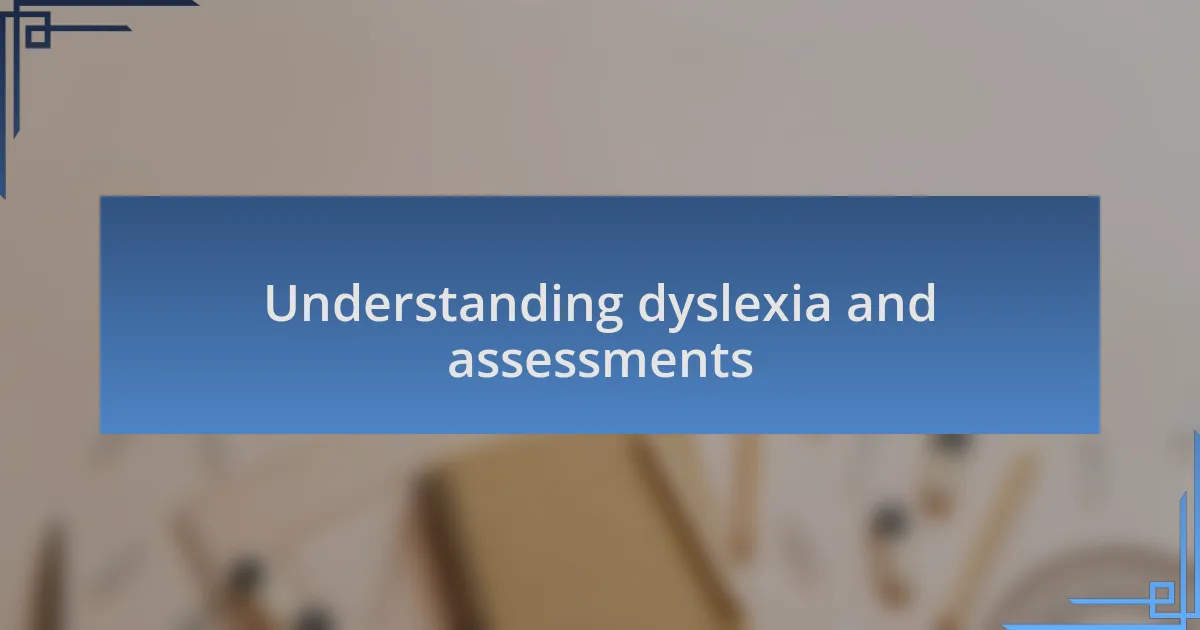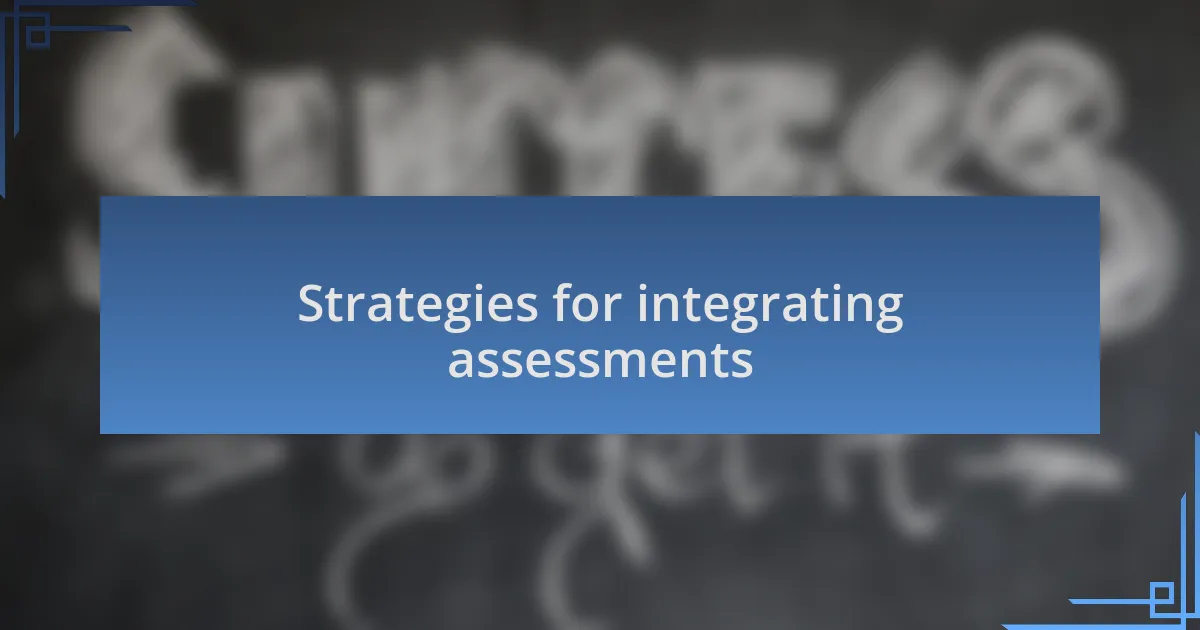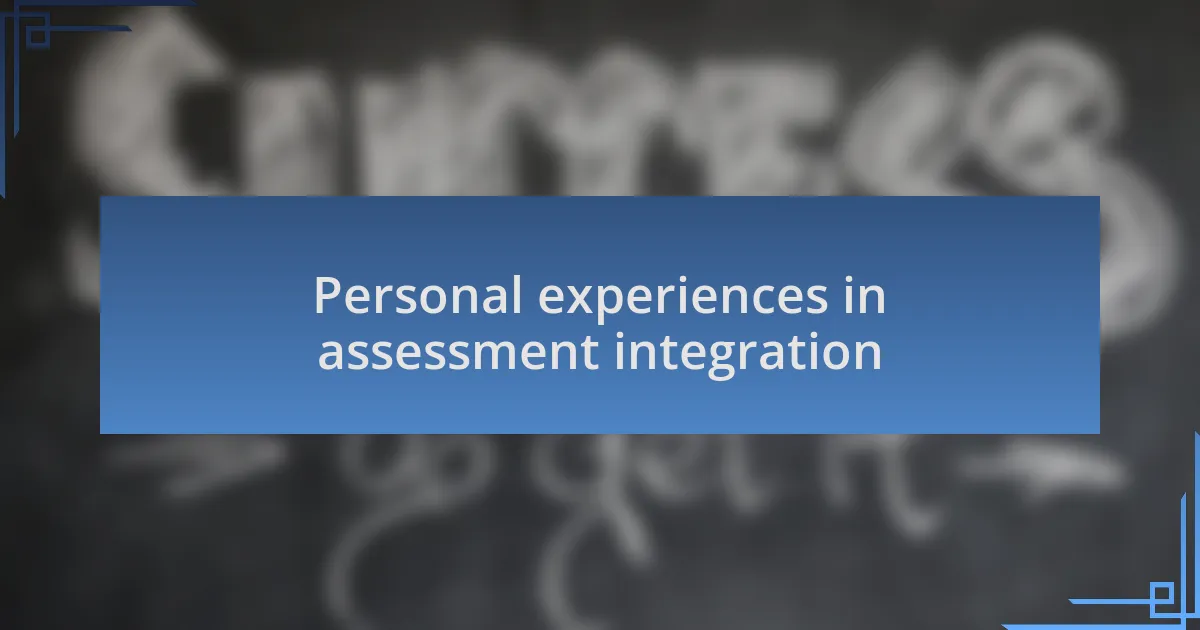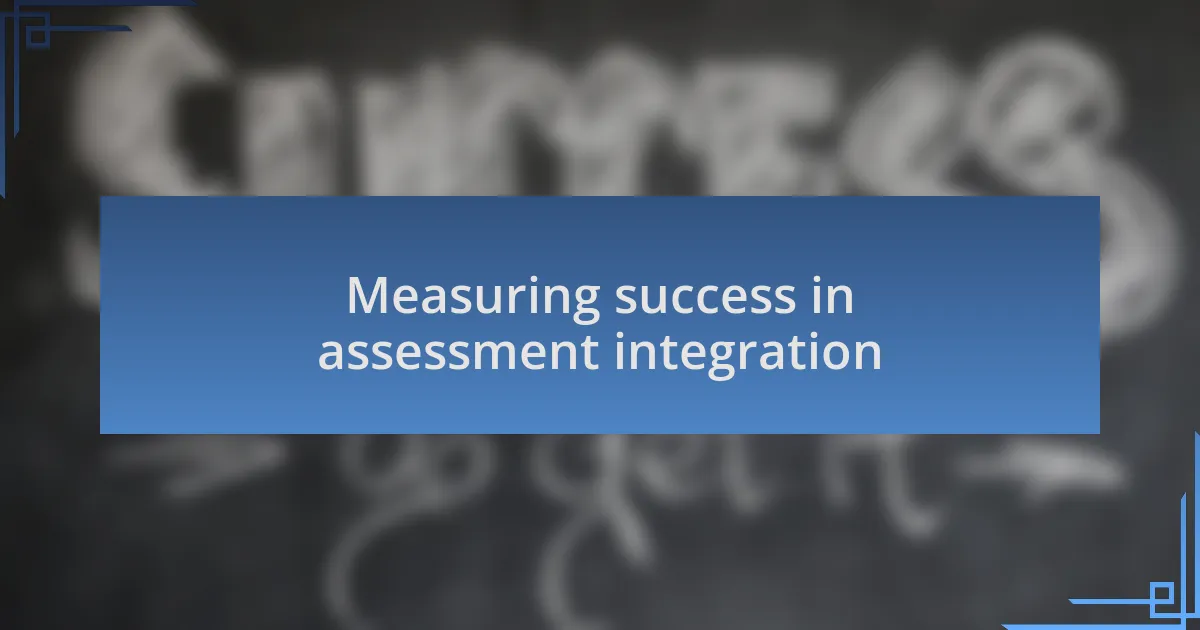Key takeaways:
- Assessments should be tailored to reflect individual learning styles and strengths, rather than serve as labels for students with dyslexia.
- Combining formal and informal assessments, along with self-assessment techniques, provides a holistic understanding of students’ abilities and challenges.
- Engaging students in collaborative assessments and interactive tools can enhance their learning experience and foster self-ownership.
- Success in assessment integration is measured by student reflections, increased engagement, and maintaining open communication with parents.

Understanding dyslexia and assessments
Understanding dyslexia requires us to look beyond just reading difficulties. When I first encountered students with dyslexia, it struck me how each one experienced their challenges uniquely, shaping the ways they approach learning. Have you ever wondered how assessments can truly capture these individual experiences?
Assessments, when thoughtfully integrated, can provide insights that go beyond standard measures of reading and writing. I remember working with a student whose test results didn’t reflect his intelligence; in fact, it was his creativity and problem-solving skills that shone through when I adjusted the assessment methods. This instance made me realize that accommodating assessments can not only reflect a learner’s strengths but also foster confidence.
It’s crucial to remember that assessments should not serve as a label but rather as a tool for understanding. How can we create an environment where students feel seen and valued for who they are, rather than what they struggle with? Personal experiences have taught me that when we focus on holistic and adaptable assessment strategies, we empower students with dyslexia to thrive academically and emotionally.

Importance of assessments in learning
Assessments play a pivotal role in the learning journey, functioning as a compass that guides educators in understanding each student’s unique needs. I recall a time when a formative assessment revealed a hidden talent in a student who struggled with traditional formats. This experience reaffirmed my belief that when assessments are tailored to reflect individual styles, they can illuminate strengths that might otherwise remain in the shadows.
The emotional weight of assessments cannot be overlooked; they have the power to build or break a learner’s confidence. I remember a student who faced repeated failures on conventional tests, which led to a deep-seated fear of failure. By switching to an alternative assessment method, I noticed a remarkable shift in her demeanor—suddenly, she was eager to participate and showcase her true abilities. Isn’t it astounding how the right assessment approach can transform a student’s self-perception and engagement?
Integrating assessments into learning is not just about measuring progress; it’s about cultivating an environment where each student feels valued and understood. When I reflect on my journey, I often question whether we, as educators, are doing enough to create assessments that resonate with our learners’ realities. In my experience, fostering this reflective practice ensures that assessments become a source of empowerment rather than anxiety, allowing learners with dyslexia to navigate their educational paths with greater ease.

Types of assessments for dyslexia
When assessing dyslexia, a combination of formal and informal assessments is crucial. I often utilize standardized tests to gauge reading abilities, which provide an objective measure of a student’s challenges. However, I’ve found that informal assessments, like observations during reading exercises or discussions with the student, can reveal nuances that numbers alone might miss. How often do we overlook the stories behind those scores?
Another valuable tool is the use of dyslexia-specific screening assessments. These are designed to identify phonological processing deficits and other areas of difficulty commonly associated with dyslexia. I remember administering a screening tool that helped a student understand where his struggles stemmed from, sparking not just awareness but also a sense of relief that there was an explanation for his challenges. Isn’t it fascinating how pinpointing the root of a struggle can change a student’s entire outlook toward learning?
Finally, I frequently incorporate self-assessment techniques, allowing students to reflect on their learning strategies. This can empower them by fostering ownership of their educational journey. I had one student who, through self-assessment, discovered that breaking tasks into smaller, manageable steps made learning feel less overwhelming. Isn’t it essential for students to find strategies that work for them, showcasing their unique strengths in the process? By harnessing a variety of assessment types, we can create a more holistic understanding of each learner’s path.

Strategies for integrating assessments
Integrating assessments into learning requires a thoughtful approach. One strategy I’ve found particularly effective is the use of formative assessments that provide real-time feedback. For instance, while working with a small group, I could see the moment a student grasped a concept just by watching their facial expressions and engagement. That’s when I realized assessments don’t always have to be formal; sometimes, the best insights come from understanding a student’s immediate reactions.
Another strategy involves tailoring assessments to fit the individual needs of students. I remember one student who thrived when I integrated technology into assessment. By using interactive apps that aligned with their interests, they became more engaged and demonstrated their understanding in a way that felt natural to them. Isn’t it interesting how the right tools can unlock a student’s potential and turn assessments into empowering experiences?
Additionally, I’ve discovered the power of collaborative assessments, where students work together to problem-solve or create projects. This not only fosters teamwork but also allows students to learn from each other’s strengths. I once facilitated a group project where students with varying abilities guided each other through challenges. Witnessing the camaraderie and support was heartwarming. Don’t you think it’s incredible how collaboration can brighten the learning journey for students with dyslexia?

Personal experiences in assessment integration
When I think about integrating assessments, a memorable experience comes to mind. There was a time when I designed a simple reading activity that transformed my students’ attitudes towards self-assessment. As they took turns reading aloud, I encouraged them to share how they felt about their progress. The smiles and nods of agreement from the group as they celebrated each other’s small victories were a reminder of the importance of creating a supportive environment focused on growth rather than purely grades.
I also recall a time when I sat down with a student who consistently struggled with traditional assessments. We decided to embed storytelling into their evaluation. By allowing them to express their understanding of a subject through creative writing, I witnessed a remarkable shift. This student not only embraced the assessment but thrived in it. Isn’t it fascinating how a slight change in approach can unveil hidden strengths that standardized tests often overlook?
There’s something uniquely rewarding about observing students take ownership of their learning through assessments. In one instance, I facilitated a peer-review session where students provided constructive feedback to each other’s work. The pride they felt when recognizing their peers’ growth was palpable. It struck me then just how powerful it is to enable students to engage in the assessment process actively. How often do we think about the hidden potential in giving students a voice in their learning journey?

Measuring success in assessment integration
Measuring success in assessment integration often requires looking beyond traditional metrics. I remember when I implemented student reflections after assessments. Initially, I was skeptical about their usefulness, but the depth of insight I gained was eye-opening. Students articulated their learning strategies and challenges, giving me a clearer picture of their progress that grades alone never revealed. Isn’t it remarkable how self-reflection can bridge the gap between effort and understanding?
Another key indicator of successful assessment integration is student engagement. In one of my classes, I introduced a project-based assessment where students chose topics they were passionate about. The shift in their level of enthusiasm was palpable; they weren’t just completing assignments; they were investing their time and energy into something they genuinely cared about. Seeing their excitement made me realize that when students see assessments as tools for personal exploration, their intrinsic motivation to learn skyrockets.
I’ve also found that maintaining open communication with parents can be a crucial aspect of measuring success. In one instance, after sharing detailed progress reports with parents that included student reflections, I was flooded with positive feedback. Parents appreciated the clarity it provided and felt more connected to their child’s learning journey. This collaboration not only strengthened the home-school relationship but also highlighted the collective responsibility we share in fostering student growth. How often do we pause to consider the impact of such partnerships in education?